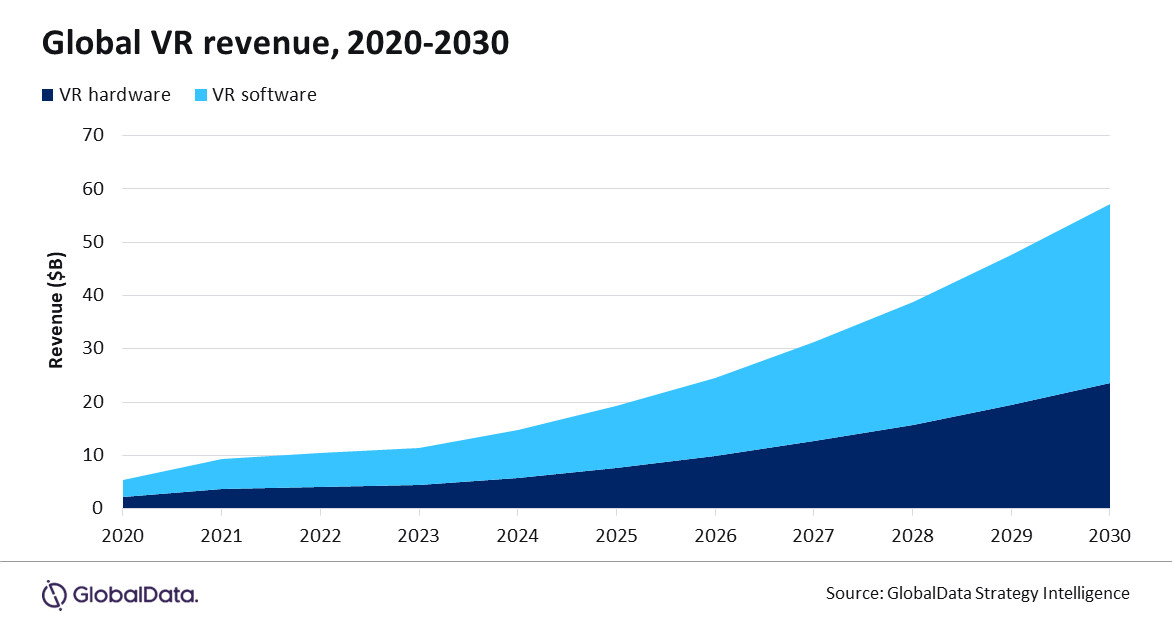Exploring the Course of the Virtual Reality Market Towards a $57 Billion Value by 2030 and Its Implications for Training Globally.
In Brief
GlobalData forecasts a remarkable annual growth rate of 26% for the VR sector, predicting it will surge to $57 billion by the year 2030, despite possible challenges facing widespread acceptance.

The global VR market is anticipated to grow significantly from $11 billion in 2023 to an impressive $57 billion by 2030, even in the face of potential obstacles to mainstream acceptance, as per the latest insights from GlobalData. This escalation represents a stellar 26% compound annual growth rate (CAGR) during this period. For stakeholders navigating this evolving landscape, it's crucial to understand the factors driving this growth, the influences at play, and the challenges on the horizon. Market Trends: The Rise of Software and Hardware.
A host of factors, such as technological advancements, falling prices, and shifting consumer preferences, are driving the boom in the virtual reality sector. According to GlobalData’s Strategic Intelligence report, the share of VR hardware revenue is projected to climb from 39% to 41%, while the proportion of revenue from VR software is set to drop from 61% in 2023 to 59% in 2030. This shift highlights a growing emphasis on hardware as VR technology becomes more accessible.
The burgeoning demand for VR software is being fueled by the production of more immersive experiences and innovations in content creation technologies. As developers enhance the quality and interactivity of applications, users are expected to become increasingly immersed in VR. Additionally, the anticipated decline in the cost of VR headsets is likely to attract a wider audience and encourage broader adoption. A noteworthy evolution in the VR arena is the transition to mixed reality (MR), which fuses virtual elements with the real world. This shift is becoming increasingly appealing for VR hardware manufacturers as they seek to expand their product offerings. Companies like HTC, Meta, and Pico, that initially focused solely on virtual reality headsets, are now exploring MR solutions. For instance, HTC's Vive Focus 3, launched in 2022, is a standalone MR headset, while Meta is integrating MR capabilities into its existing headset range. Apple’s Vision Pro, anticipated to release in early 2024, exemplifies this mixed reality trend, signaling the industry's potential pivot toward this technology. MR's ability to blend digital and physical environments opens doors to opportunities across various fields such as design, education, and healthcare, enhancing user experiences and engagement throughout different sectors.

While the VR market shows promise for growth, several hurdles could impede progress. The expense associated with VR headsets, usually ranging from $200 to $1,000, poses significant challenges. Many potential users may find it difficult to purchase the high-performance devices required, especially for tethered headsets.
Mixed Reality’s Ascent
Health risks linked to prolonged VR usage are another area of concern. Users often report issues like motion sickness, headaches, and eyestrain, which can deter some potential adopters. Addressing these health concerns through improved design and user experiences is essential for the long-term success of VR. This could involve developing lighter and more comfortable headsets, as well as enhancing software to mitigate discomfort.
A Critical Aspect of the Content Ecosystem.
Overcoming Adoption Obstacles
The success of virtual reality technology heavily relies on the availability of engaging and diverse content. While there have been several captivating VR experiences that have drawn attention, establishing a robust content ecosystem that consistently delivers top-tier experiences remains a challenge. A lack of varied applications and experiences could limit the appeal and growth of VR technology.
Content creators must focus on crafting captivating experiences that resonate with users. This means exploring various genres, ranging from entertainment and gaming to training and education. As numerous developers step into the VR field and experiment with innovative material, the likelihood of developing a thriving ecosystem increases.
Strategic Insights for Stakeholders.
With the global VR industry projected to attain a valuation of $57 billion by 2030, industry players need to stay vigilant and adapt to the evolving landscape. Companies producing VR software and hardware should meticulously strategize their approaches. Some may choose to hone in on enhancing VR capabilities, while others might pivot towards mixed reality.
Investments in research and development will be crucial for businesses looking to offer groundbreaking products that fulfill shifting consumer demands. Partnerships with developers and content creators can significantly bolster the growth of a diverse content ecosystem, ensuring consumers have access to engaging experiences.
The forecast for the global virtual reality market suggests a promising future filled with considerable growth and innovation. Despite facing concerns related to cost, health, and content creation, advances in technology and evolving consumer preferences create an optimistic climate for the sector.
As VR technology continues to evolve, stakeholders must proactively tackle these challenges and seize opportunities to reach a larger audience. The transition toward mixed reality could be pivotal in shaping the future of the VR industry, offering fresh avenues for interaction and expansion.
In summary, achieving a $57 billion valuation for the global VR market by 2030 will require collaboration, creativity, and a deep understanding of market dynamics. The industry's ongoing dedication to crafting immersive experiences and overcoming barriers will be essential for unlocking the full potential of virtual reality technology.
Virtual Reality’s Future
Please be aware that the details provided on this page are not meant to be considered, nor should they be interpreted as, any form of legal, tax, investment, financial, or other professional advice. It's vital to invest only what you can afford to lose, and seek independent financial counsel if you're uncertain. For further details, we recommend reviewing the terms and conditions along with the help and support resources provided by the issuer or advertiser. MetaversePost strives for accurate, impartial reporting, but market conditions may shift without notice.
Victoria is an experienced writer focusing on various tech topics including Web3.0, AI, and cryptocurrencies. Her extensive background enables her to produce insightful articles for a broad audience.
Shardeum Empowers Validators and Unveils a Roadmap for Autoscaling Mainnet.
Disclaimer
In line with the Trust Project guidelines Bitcoin, Ethereum, Toncoin: Recap of Last Week’s Crypto Surge – Comprehensive Update and Prospects.







